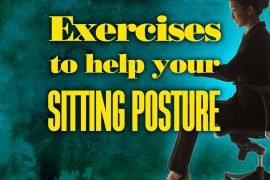Digging in deeper, it implies that the skull protrudes forward more than one inch over the first vertebrae in the neck, known as the atlas. According to studies, it is one of the most common deformities affecting around 66% – 90% of the population.
It mostly affects people who do not sit properly while spending too much time on their computers and those who do not sleep in the right position. Thankfully, it is not a posture that someone has to live with.
Here are some of the most effective solutions on how to fix forward head posture fast.
Perform Exercises that Improve Posture: Useful Options on How to Fix Forward Head Posture Fast
Table of Contents
Stretches and exercises can help return your posture to what it is supposed to be. Some exercises that produce excellent results include:
- Chin Retractions – Pull the chin back in order to stretch your neck muscles. Repeat this about ten times every hour throughout the day to get positive results.
- Chin Tuck – It is very similar to the chin retractions, but you should perform them while lying down. Make sure there is nothing under or behind your head and then tuck the chin in a way that it comes down towards the chest. Hold this position for about five seconds, without lifting the back of your head. Go back to the original position and repeat ten times.
- SCM (Sternocleidomastoid) Release – Locate the SCM which is on both sides of the neck running from the middle of the throat all the way to behind the ears connecting to the collarbone. Gently massage the area by rolling it between the fingers and pinching both sides. Work on the entire muscle for about a minute without pressing it too much.
Adjust the Distance and Height of your Computer
Your computer should be at an appropriate height and distance from your face if you spend extended periods of time in front of it. Ensure that the top third of the screen is at eye-level. The screen should be around 18-24 inches away from the face.
When the monitor is too close, it may result in undue strain on the eyes causing you to slouch forward. A computer or laptop that is too low or high from eye-level also causes a person to strain their neck and eyes.
Invest in an Ergonomic Chair
An ergonomic chair will not only strengthen the neck, but it will also contribute to correcting your posture and relieving back and hip pain. It is a great option on how to fix forward head posture fast because the ergonomic chair provides lumbar support and ensures that the natural curvature of the back is promoted. Properly aligning the back means that the neck will not drift forward. Sit upright at all times.
Lift the Chest
Most people think that tucking their heads back helps to correct posture. It is a dangerous misconception that you should never try as it typically comes with rounded shoulders and a slouched back. Instead, you must lift the chest as it will naturally retract your neck and correct rounded shoulders and slumping at the same time.
Buy a Supportive Neck Pillow
An excellent neck pillow will come as a huge relief as it ensures that the neck remains in its right position and it also prevents a sore neck. They usually follow the natural curvature of the neck and head, while holding the neck in the proper position.
Additionally, you should avoid sleeping with many pillows as they can push the neck forward in an upright position, which is not natural.
Remember always to practice healthy habits that ensure you do not develop the deformity. However, if you are already a victim, be sure to explore the above options on how to fix forward head posture fast. If left unchecked, it could become the primary reason for stiffness, tension or pain in your back, shoulders or neck.
When the symptoms go untreated, your head may continue to poke forward over time resulting in an unflattering hunched appearance.
Important Features To Fix Forward Head Posture
Here are some important features to consider when trying to fix forward head posture:
- Good posture: It’s important to maintain good posture throughout the day, with your head and shoulders aligned over your hips and your feet shoulder-width apart.
- Proper ergonomics: If you spend a lot of time at a desk or using a computer, it’s important to set up your workstation ergonomically to reduce the strain on your neck and shoulders. This includes using a chair with good back support, keeping your monitor at eye level, and using a keyboard and mouse that are at a comfortable height.
- Strengthening exercises: Performing exercises to strengthen the muscles in your neck, upper back, and shoulders can help to improve your posture and reduce the strain on your neck.
- Stretching: Stretching the muscles in your chest, neck, and upper back can help to improve flexibility and reduce muscle tension.
- Chiropractic care: Chiropractic care can help to realign the spine and improve posture.
- Massage therapy: Massage therapy can help to release muscle tension and improve mobility in the neck and shoulders.
- Awareness: Paying attention to your posture and making an effort to correct it throughout the day can go a long way in improving forward head posture.
What Causes Forward Head Posture?
Forward head posture is a common postural deviation caused by factors like poor habits, muscle imbalances, and structural abnormalities. Some of the most common causes of forward head posture include:
- Poor posture: Constantly sitting or standing in a slouched position, hunching over a computer, and holding the head forward while looking at a phone or tablet can all contribute to forward head posture.
- Weak muscles: Weakness in the neck, shoulder, and upper back muscles can cause the head to drift forward, leading to poor posture.
- Tight muscles: Tight muscles in the neck, chest, and upper back can cause the head to tilt forward and stay in that position.
- Structural abnormalities: Certain medical conditions such as scoliosis, kyphosis, and lordosis can cause abnormal curvature of the spine, leading to forward head posture.
- Injury: Trauma to the neck or upper back, such as whiplash, can cause forward head posture.
- Sleep position: Sleeping on a pillow that is too high or too low can cause the head to tilt forward or backward, leading to poor posture.
Short-Term Side Effects of Forward Head Posture
Some of the short-term side effects of forward head posture include:
- Neck pain: The most common short-term side effect of forward head posture is neck pain. When the head is positioned forward, it can cause strain and tension in the neck and upper back muscles.
- Headaches: Forward head posture can also cause tension headaches, which can be felt at the base of the skull and in the forehead.
- Shoulder pain: When the head is positioned forward, the shoulders tend to round forward as well, which can cause pain and tension in the shoulder muscles.
- Reduced range of motion: Forward head posture can limit the range of motion in the neck and upper back, making it difficult to turn the head or look up and down.
- Poor posture: Over time, forward head posture can lead to a permanent hunching of the upper back, which can cause poor posture and increase the risk of other postural problems.
Maintaining Forward Head Posture During Excessive Screen-Time
Maintaining a forward head posture during excessive screen time can lead to several problems. When you hold your head forward, the weight of your head increases, which puts extra strain on your neck and upper back muscles. Over time, this can lead to neck pain, upper back pain, and even headaches.
Additionally, when you maintain a forward head posture, it can cause a misalignment of your spine, which can affect your overall posture. Poor posture can lead to decreased lung capacity, increased fatigue, and even digestive issues.
Another factor to consider is that when you are looking at a screen, your eyes tend to be fixed in one position for an extended period of time. This can cause eye strain, which can lead to headaches, blurred vision, and dry eyes.
It’s important to take breaks regularly and to practice good posture while using electronic devices to avoid these problems. This means keeping your head aligned with your spine and taking breaks every 20-30 minutes to stretch, move around, and give your eyes a break from the screen. Additionally, practicing neck and upper back exercises can help strengthen the muscles supporting good posture.
Maintaining Forward Head Posture During Excessive Gaming
Maintaining a forward head posture during excessive gaming can lead to a condition called “text neck.” The text neck is a repetitive strain injury caused by prolonged use of electronic devices such as smartphones, tablets, and gaming consoles. It causes the head to be tilted forward for extended periods of time.
When you maintain a forward head posture, it places additional stress on your neck and shoulder muscles, leading to muscle fatigue, tension, and pain. This can also cause increased pressure on the discs in your cervical spine, leading to herniation or degeneration over time.
Additionally, maintaining a forward head posture can affect your breathing and digestion. When your head is tilted forward, it compresses your chest and limits your lung capacity, making it harder to take deep breaths. It can also compress your digestive organs, leading to discomfort and indigestion.
It’s important to maintain good posture while gaming or using electronic devices to prevent text neck and other related conditions. Take frequent breaks and stretch your neck and shoulder muscles to relieve tension. Adjust your gaming setup to promote better posture, such as positioning your monitor at eye level and using a chair with proper lumbar support. And finally, make sure to engage in regular physical activity and exercise to strengthen your neck and shoulder muscles and improve your overall posture.
Maintaining Forward Head Posture While Working On The Computer
Maintaining forward head posture while working on the computer can lead to several negative effects on your body, such as neck and shoulder pain, headaches, and even reduced lung capacity.
To prevent and correct forward head posture, try the following tips:
- Adjust your computer screen: Position your computer screen at eye level so you don’t have to tilt your head forward or look down to see it. You can use a monitor riser or adjust the height of your chair to achieve the correct screen height.
- Sit up straight: Sit with your back straight, and relax your shoulders and feet flat on the ground. Avoid slouching or leaning forward while working on your computer.
- Take breaks: Take frequent breaks from sitting and working on your computer. Stand up, stretch, and move around every 30 minutes or so.
- Strengthen your neck and upper back: Perform exercises that target your neck and upper back muscles, such as neck stretches, shoulder blade squeezes, and chin tucks.
- Use ergonomic equipment: Use a comfortable and supportive chair that promotes good posture. Consider using an ergonomic keyboard and mouse to lower strain on your hands, wrists, and arms.
Remember, maintaining good posture is important for your physical health, productivity, and overall well-being.
Things To Avoid While Suffering from Forward Head Posture
Forward head posture is a common condition that occurs when the head is positioned forward in relation to the shoulders. It leads to a number of negative health effects, including neck pain, headaches, and poor posture. To prevent further damage while suffering from forward head posture, here are some things to avoid:
- Slouching: Sitting or standing with a slouched posture can exacerbate forward head posture. Keep your back straight & shoulders relaxed to maintain good posture.
- Text Neck: Holding your phone or tablet at a low angle can cause you to tilt your head forward. It put additional stress on your neck and shoulders. Try holding your device at eye level or using a hands-free device instead.
- Carrying Heavy Bags: Carrying a heavy backpack, purse, or briefcase can put additional strain on your shoulders and neck. Try to lighten your load and use a rolling bag instead.
- Poor Sleeping Position: Sleeping on your stomach can put additional pressure on your neck and spine, exacerbating forward head posture. Keep trying sleeping on your back or side with a supportive pillow.
- Poor Workspace Ergonomics: Poor desk and workspace ergonomics can contribute to forward head posture. Ensure your desk, chair, and computer are properly adjusted to promote good posture.
- Prolonged Sitting: If you are sitting for long periods of time may cause the neck and shoulder muscles to become stiff and sore. Take regular breaks to stretch and move your body.
- Improper Exercise: Certain exercises, such as sit-ups and crunches, can put additional strain on your neck and shoulders, exacerbating forward head posture. Work with a trainer or physical therapist to develop a safe and effective exercise routine.
FAQs
Q1. What is forward head posture, and what are its long-term side effects?
Forward head posture is a condition that occurs when the head is positioned forward from the shoulders. Long-term side effects of this condition include headaches, neck pain, and even nerve compression.
Q2. What causes forward head posture, and how can it be prevented?
Forward head posture is typically caused by poor posture habits, such as slouching or spending too much time sitting at a desk. It can be prevented by maintaining good posture, taking regular breaks, and engaging in neck-strengthening exercises.
Q3. What are the most common symptoms of forward head posture?
The most common symptoms of the forward head posture include neck pain, headaches, shoulder pain, and tightness in the neck and upper back.
Q4. Can forward head posture cause nerve damage?
Yes, forward head posture can compress nerves in the neck and shoulders. It leads to numbness, tingling, and even weakness in the arms and hands.
Q5. How is forward head posture diagnosed?
A physical examination and a review of symptoms are typically used to diagnose forward head posture. In a few cases, imaging tests such as X-rays or MRI scans may be used to confirm the diagnosis.
Q6. What are the treatment options for forward head posture?
Treatment options for forward head posture include physical therapy, chiropractic care, and massage therapy. In most serious cases, surgery may be necessary to correct the condition.
Q7. Can forward head posture be cured?
Yes, with proper treatment and lifestyle changes, forward head posture can be corrected and even cured.
Q8. How long does it take to correct forward head posture?
The length of time it takes to correct forward head posture varies depending on the severity of the condition and the effectiveness of the treatment plan. Sometimes, it may take several weeks or even months to see significant improvement.
Q9. What are lifestyle changes that can help prevent or treat forward head posture?
Lifestyle changes that can help prevent or treat forward head posture include:
- Maintaining good posture.
- Taking frequent breaks.
- Engaging in regular exercise.
- Avoiding prolonged periods of sitting or standing.
Q10. Is forward head posture a serious condition?
While forward head posture may seem like a minor condition, it can lead to serious long-term side effects if left untreated. It is important to seek treatment immediately to prevent further damage and alleviate symptoms.
Conclusion
Forward head posture can lead to a number of negative consequences, including neck and back pain, headaches, and decreased range of motion. By implementing exercises to strengthen the neck and upper back muscles, along with stretches to improve flexibility, it is possible to improve forward head posture and reduce the associated symptoms. Additionally, incorporating good posture habits into daily life, such as sitting up straight and using ergonomic equipment. It can help prevent the development of forward head posture. It is essential to consult with a healthcare professional or physical therapist before starting any exercise program to ensure that it is safe and appropriate for your individual needs.
FixForwardHeadPostureWant to use this infographic on your site?


![How to Fix Forward Head Posture Fast-An Ultimate Guide [Updated] Businesswoman touching her neck](https://yourbodyposture.com/wp-content/uploads/2018/04/neck.jpg)





